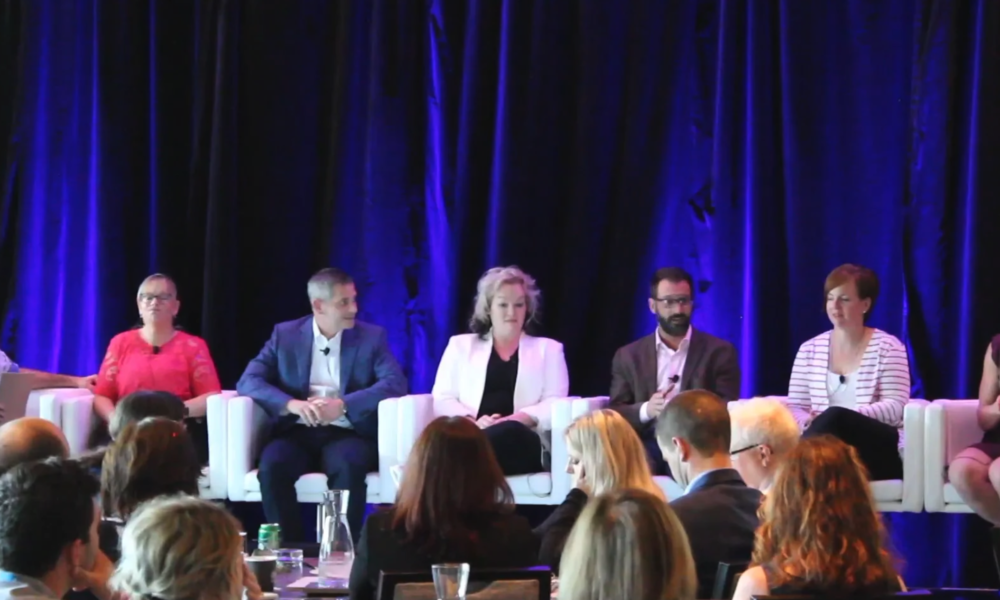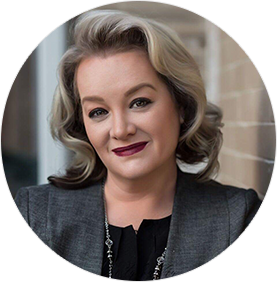Episode 61: Helen Cummins on Transforming Mindsets with Change Management
5.7K Views | 14 Min Read
Shawnna Sumaoang: Hi, and welcome to the Sales Enablement PRO podcast. I am Shawnna Sumaoang. Sales enablement is a constantly evolving space and we’re here to help professionals stay up to date on the latest trends and best practices so they can be more effective in their jobs.
Today, I’m excited to have Helen Cummins join us. Helen has a wealth of experience leading global sales enablement organizations. Helen, I would love for you to introduce yourself to our audience.
Helen Cummins: Well, sure. Thank you. My name is Helen Cummins and I have a sales and marketing background, and for the past 10 years, I’ve been leading global sales enablement teams within the tech industry. Prior to that, I was leading product marketing, and then at the beginning of my career, I was focused on actually selling to the larger financial services accounts in Toronto.
SS: Well, I’m excited to have you on our podcast today, Helen, so thank you for joining us. One of your areas of expertise is changing management, and I think that is an extremely popular topic within the sales enablement space. In your opinion, why is change management an important area of focus for sales enablement?
HC: Well, because sales is rapidly changing and in fact, it’s getting harder. So, showing up at customer meetings and asking really good questions, well, it’s not going to cut it anymore. The reality is that our customers are buying differently.
So, let me provide a few examples of what we’re seeing. First, the fact that customers are often two thirds along the way in researching their solutions before they even call a sales rep so they can get product information, pricing, references, and demos. They can get this over the internet, and it used to be that they depended on sales to provide this information. Well, no more.
Customer expectations are higher with regards to their experiences working with you. So, they want more personalized engagement and they have the means to be very disruptive when they’re not happy. We’ve all seen examples of this where companies are shamed using social media and it can be very damaging to their brand.
There are additional personas as well. They’re becoming more and more important in the selling process. So, this could include people like the solutions architects or customer service reps, for example. This means that the number of personas that we as enablement professionals have to train has increased.
And then just one more I want to mention is tools, especially in machine learning and AI, which is intending to enhance the customer buying experience. They’re being deployed more and more. So, sales enablement can help bridge the gap between how customers are buying and how customers and how companies are selling to them. That requires skillful change management capabilities.
So, working cross-functionally, as we do so well, we’re in a unique position to train all the new personas now engaged in selling and to train them on new and more effective selling methodologies. There are a few good ones out there I won’t mention, but there are some key ones that we all are aware of. We can also communicate and reinforce change messages early and often and we can help lead the adoption of any tools needed to set the company up for success moving forward.
SS: And from your perspective, how can change management help sales enablement transform from what some organizations may today see as a tactical function to a more strategic one?
HC: Well, that’s a good question. And I’ve actually had to drive this kind of transition in the past. When I was hired to lead enablement at a company that I previously worked for, I discovered that the scope and skills of that organization were very focused on traditional training and on-demand. So, it was a very tactical organization, and my vision was to expand the role and contribution of this team and make it more of a strategic differentiator for this company. I had to redirect the talent to serve a much broader scope. I had to repurpose the content to better align with the needs of the field and introduce new ways of engaging and selling to our customers.
So, as I mentioned earlier, we picked one of the leading selling methodologies currently on the market. I also had to launch new programs, new processes, and better metrics. The organization also expanded to include additional roles and talent, and it’s now leading coalition forums that meet regularly to ensure, very importantly, organizational alignment on company priorities moving forward.
Today I’m pleased to report that that enablement organization is much better engaged in company success and viewed very positively.
SS: Fantastic. And I do want to eventually return to that note on talent and culture. But let’s dig a little bit deeper into change management. I would love for you to provide our audience with some change management strategies that you’ve used to help turn underperforming teams around.
HC: Sure. So, when you start change management efforts, leveraging best practices is really helpful. I personally like the work that John Kotter at Harvard University has done. It’s an excellent start and I encourage you to look them up. At any rate, my approach has been this: first, it’s to understand the situation and create a forum with your stakeholders, folks like leaders from PM or from the field. And then you’re going to want to discuss and align on what the key issues are.
Second, develop a vision and define an agreed action plan. At this stage, having enablement and key stakeholders agree on the vision and plan is critical for the successful execution of the transformation.
Third, communicating the vision to everyone who needs to know. So, ensuring that why we’re making these changes is clear as part of that message. And then during the execution of the plan, you want to consistently reinforce the vision. You want to raise visibility of short-term wins. And this one I have found really important, and it’s publicly recognizing and rewarding people who are moving things in the right direction. It really sets the right tone.
And then finally, not taking your foot off the pedal until the plan has been executed and the new way is really part of the culture. You’ve got to persevere. You may have to make adjustments along the way, and I use metrics to help identify the impact, but making tweaks, that’s normal. That’s expected.
SS: I love those steps. That’s absolutely fantastic and that’s a great strategy approach to change management. Thank you. How can sales enablement use change management strategies to help companies navigate larger organizational change, such as mergers and acquisitions?
HC: Well, you know, I went through this exercise at one of the companies that I previously worked for, and I can tell you that going through an acquisition and leading a change management effort where you are not only an enabler but also simultaneously impacted by change, it’s not easy. And what I’ve learned is that change management efforts will likely fail if enablement isn’t engaged early or seen as a partner in the process.
So, an acquisition is a cultural shock and it’s a cultural shock to both the acquired company and the acquiring company. For people to succeed in such unfamiliar territory, they need to clearly understand the vision and plans that are being rolled out and why it matters, because they’re fearful. People are restless. They need reassurance, again, and it’s on both sides. And you want to avoid disruption to the business as much as possible.
It starts with communication. So, the enablement team can play a role in communicating and reinforcing, clearly and simply, the core messages and new practices. Additionally, we can implement training and programs that help teams transition more easily and in a timelier manner.
SS: Absolutely. I think sales enablement is very uniquely positioned to help with change management, particularly in some of those larger organizational changes.
Now, that said, there are obviously some challenges that come along with change management. What are some of the ones that you’ve come across?
HC: In my experience, the biggest change is to get people’s mindsets around supporting the vision and implementing the changes and then sticking to the new way of doing things. I’ve mentioned this a couple of times, that you really need to define why change is needed and why it’s the right way to go. So, how many times do we run into occasions where the vision wasn’t clear or is in contradiction to existing core values? I mean, change is really hard. And if people can’t share the same vision, then you’re not going to be able to successfully execute in the new direction.
One of the things that I’ve learned is that it’s key to be prepared and to have partners that share that vision at the onset and frankly, who will collectively help achieve results when the organization hits roadblocks. So, I guess to say the cliché, partner early and partner often, as they say.
SS: Absolutely. Now, let’s flip to the end of the story arc. What are some of the ways in which you measure the impact of change management initiatives?
HC: It really depends on what you’re changing, but let’s say you’re changing or introducing a new selling methodology. Metrics need to be defined early in the process. So, your performance metrics like revenue attainment, percentage of the field that makes quota, year-over-year growth, those all still apply, but so do productivity and standard proficiency metrics.
That said, what’s really important to note is that measurements are just a snapshot of where you are at any given time. To really measure impact, you want to measure how the results are trending over time and then course-correct as needed.
SS: I love that. And I think that’s spot on. In closing, I want to go back to that notion around culture. Change has a massive impact on culture. People, as you said, are naturally averse to change. So, how can sales enablement help maintain or even improve culture? And what role can sales enablement play in improving seller morale or impacting retention in a positive way?
HC: Okay. Well, another great question. A large-scale change initiative, it can be doomed if you ignore how employees feel about it. So, simply changing the habits and the processes that employees follow is not enough.
In fact, McKinsey recently reported that when companies take the time to address employees’ mindsets, they are four times more likely to rate these engagements as successful. So, you’ve got to get everyone rallied behind the changes and it has to come at a rolling thunder of positive communication and engagement with all the impacted employees. It will take a change in mindset. It’s going to take executive sponsorship, and it’s going to take inspiring the entire organization to make the changes accepted and permanent.
Now, enablement can help by creating support materials and delivering guidance and training throughout. And your audience needs to be including both leaders and individuals affected by the changes. So, efforts could include – and these are efforts from sales enablement – webinars that we put on, guides and presentations, helping to modify the business processes. And again, what I’ve also found important to do is recognize those who successfully adopt change, promoting them as an example of what success could look like.
SS: Fantastic tips. Well, thank you so much, Helen, for joining us today. I really appreciated the chance to chat with you.
HC: My pleasure. Thank you.
SS: To our audience, thanks for listening. For more insights, tips, and expertise from sales enablement leaders, visit salesenablement.pro. If there’s something you’d like to share or a topic you’d like to learn more about, please let us know. We’d love to hear from you.
















